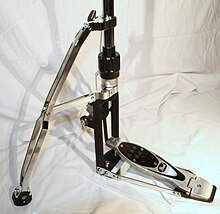Hi-hat

The hi-hat is part of a drum kit and enables the drummer to hit cymbals in the style of pair cymbals without using their hands.
Jo Jones developed the modern way of playing the hi-hat, in which the opening and closing pools are played with sticks.
development
The hi-hat developed in the 1920s from the "Charleston machine", which functioned similarly in principle, but had a very low stand that did not allow the cymbals to be played with sticks , hence the designation "low- Hat ”or“ Low-Sock ”. The development step towards today's hi-hat is attributed to the drummer Vic Berton .
construction
The hi-hat consists of a pool -pair mounted horizontally on a stand with a pedal. This enables the hi-hat to be opened and closed with the left foot in the standard set-up using a spring balancer.
The structure and mechanics of the hi-hat can vary. There are hi-hat mechanisms that work in direct pull - with them, the pedal is directly connected to the spring balancer. High-quality hi-hats divert the foot force via a pulley to the pull rod. These guide systems can be shaped differently and interchangeable. Depending on the shape of the chain guide, the feel of the game and thus the sound changes. The feel of the game also depends on the spring tension of the train, which can also be changed with high-quality devices.
The classic hi-hat machine has three mostly double-braced legs with rubberized feet. The feet are usually also equipped with spikes. More modern versions are also available with just two rotatable feet and a base plate of the pedal for sufficient stability. This two-legged design or at least a rotatability of the foot struts are required if the second pedal of a double pedal for single bass drums is to be found in addition to the hi-hat.
The upper of the two basins ("top") is attached to the pull rod with a so-called clutch. There are also different forms here. The classic clutch is screwed into the opening and guided over the pull rod. It is firmly connected to her by a screw. The drop clutch is used when playing with the double foot pedal. It then makes it possible to close the hi-hat when both feet are operating the bass drum. The drop clutch has a lever that releases the connection to the pull rod with a blow with the stick and lets the upper basin fall onto the lower one ("bottom"). This means that the hi-hat is closed even without using the pedal. When you step on the pedal, the hook grips the upper pelvis again and the hi-hat works as usual.
Sound generation
Closing the hi-hat cymbals with the pedal produces a comparatively quiet sound similar to that of a cabasa (“chick”). In traditional jazz it is customary to use it to mark the beats “2” and “4”. In contrast to the ride bell, the hi-hat bell is used less often, for example in industrial rock .

Modern music makes use of the many possibilities that are offered by striking the hi-hat cymbals with sticks while simultaneously using the pedal: when closed, striking produces a fine sound, and when half-open a rougher ("rocky") sound , when open, a loud sound similar to that of a crash pool. Striking the cymbals when they are open and closing immediately sounds particularly interesting because the sound is "cut off" - a trademark of Phillysound . The use of the open hi-hat on unstressed beats (and the closing on the accented beats) is typical of the reggae and disco styles .
The sound also varies depending on the strength and size of the hi-hat cymbals. The smaller and thicker the cymbals, the sharper and brighter they sound. Most hi-hats are 12 to 15 inches in diameter. To enable the air to escape more quickly between the pair of cymbals when the hi-hats are closed, there are hi-hat cymbals in which the edge of the lower cymbal is wavy. This cymbal shape was first introduced by Paiste as the "Sound Edge". Other manufacturers have implemented this with several holes or recesses ("ReZo" by Zildjian) in the lower basin, but are increasingly using the corrugated edge of the lower basin (for example "Air Wave" by Sabian , "Mastersound" by Zildjian or "Soundwave") von Meinl ). The upper pelvis (“top”) is usually lighter and thinner than the lower (“bottom”).
Web links
Individual evidence
- ↑ drummagazine.com: Drumming Innovators: Papa Jo Jones ( Memento from October 8, 2015 in the Internet Archive )
